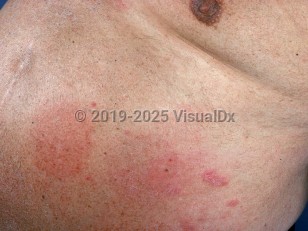Systemic contact dermatitis (SCD) occurs when systemic exposure to a hapten triggers a
contact-type allergic dermatitis, typically causing flares at previous sites of contact dermatitis. SCD has been reported with medications administered orally, transcutaneously, intravenously, per rectum, intravesically, or by inhalation. Other allergens include metals (eg, nickel, cobalt, mercury, gold, chromate), plants (eg,
Anacardiaceae,
Compositae,
Apiaceae,
Asteraceae,
Parthenium hysterophores,
Myroxylon balsamum), foods and beverages (eg, garlic,
shiitake mushroom, flaxseed, ethanol), chemicals (eg, acrylates, propylene glycol), medical devices and implants, and aromatic substances (eg, spices, cashew oil smoke). The exact mechanism of SCD is unclear; however, patients can react within hours of the systemically administered drug, suggesting that a Type III as well as Type IV sensitivity reaction may be involved.
The following medications have been reported to cause systemic contact dermatitis:
- Erythromycin
- Penicillin
- Aminoglycosides: gentamicin, streptomycin, kanamycin, and topical neomycin can cross-sensitize
- Tolbutamide or chlorpropamide in patients sensitized to paraphenylenediamine or paraaminobenzoic acid (PABA) or its esters, or benzocaine
- Phenothiazine in patients sensitized by topically cross-reacting or related antihistamines
- Edetate disodium due to exposure to azelastine nasal spray
- Acetylsalicylic acid from oral aspirin / acetylsalicylic acid
- Aminophylline in people with ethylenediamine allergy
- Amlexanox
- Intravesical dimethyl sulfoxide
- 5-aminosalicylic acid
- Codeine
- Diclofenac
- Hydroxyquinoline
- Prednisone
- 8-methyoxypsoralen
- Nystatin
- Phenobarbital
- Pseudoephedrine
- Tetraethylthiuram disulfide
- Vitamin C
- Vitamin B6
- Thimerosal from oral or nasal antipneumococcal vaccine
Related topics:
Baboon syndrome,
Symmetric drug-related intertriginous and flexural exanthema (SDRIFE)



